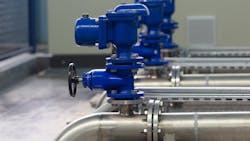Application Corner: Total plant flow measurement system for sewage flow
Previous articles described the sewage collection systems for two adjacent sewage districts and how the flowmeters measuring the sewage generated by the first sewage district measured higher than the actual sewage flow.
My recollection is that the total plant flowmeter was installed properly; however, it operated with poor accuracy. In particular, the flowmeter primary element produced a squared output differential pressure signal that was measured using a differential pressure transmitter with capillary tubes and diaphragm seals. The total plant flow measurement system was sized to measure the maximum possible flow into the sewage treatment plant. However, flow rates under normal operation were significantly lower, especially at night. Therefore, the performance of the differential pressure transmitter was poor because it continuously operated low in its flow range due to the nonlinear relationship between flow and differential pressure.
You may recall that the sewage generated by the second district was calculated as the total plant flow minus the sum of the four measured sewage flows generated by the first sewage district. The effects of the errors associated with these flowmeters were so large that the sewage flow generated by the second district was actually negative during one 24-hour day. Stated in more practical terms, the population in the second sewage district did not flush any toilets, did not clean any dishes, did not wash any clothes and did not take any showers on that day, but rather consumed a few thousand gallons of sewage from the first sewage district. This is clearly not possible and is proof that something was amiss, and it was not due to an isolated event.
This discussion will be continued next issue.
David W. Spitzer is a principal at Spitzer and Boyes, LLC, which offers engineering, focused market research, writing/editing white papers, strategic marketing consulting, distribution consulting, seminars and expert witness services for manufacturing and automation companies. Spitzer has written more than 400 technical articles and 10 books about flow measurement, instrumentation and process control. He can be reached at 845-623-1830 or via spitzerandboyes.com.
About the Author
David W. Spitzer
David W Spitzer’s new book Global Climate Change: A Clear Explanation and Pathway to Mitigation (Amazon.com) adds to his over 500 technical articles and 10 books on flow measurement, instrumentation, process control and variable speed drives. David offers consulting services and keynote speeches, writes/edits white papers, presents seminars, and provides expert witness services at Spitzer and Boyes LLC (spitzerandboyes.com or +1.845.623.1830).
